So, where were we? Oh, yeah, Austin, at the top-secret all-star blow-your-mind-empty-your-pockets fund raiser for Bernie Tiede’s resentencing trial, featuring appearances from Oscar-nominated director Richard Linklater, lots of people with suits and wallets, the dulcet tones of Tenacious D and, looking alternately grateful and out of place, Bernie himself.
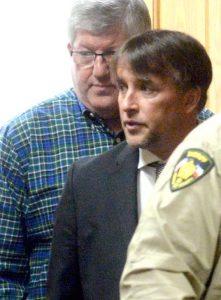
Bernie Tiede & Richard Linklater entering the courtroom.
Richard Linklater gave a speech that night, a thing which he absolutely hates to do. While Jack Black was a glad-handing machine and Bernie was uncomfortably thanking small clusters of strangers, Linklater stood back in the corner of the Brazos Hall banquet space, speaking when spoken to, but otherwise trying to be the least visible person in the room. This, by the way, is exactly how he is on the set, a presence so low-key that you could easily mistake him for a production assistant. If he didn’t shout “Action!” – and sometimes he doesn’t – you’d never guess he was the director.
But, we digress. The speech was partly an obligatory thank-you to those who’d ponied up cash but mostly a heartfelt explanation of why he’d gotten so deeply involved in Bernie’s case.
He talked about how he’d first been intrigued by the contradictions the case seemed to represent – a murderer who was adored by everyone who knew him, a victim as universally disliked as Bernie was beloved. As premises go, that’s a pretty good place to start. When you add in that Bernie put her body in the freezer, carrying on for 9 months as if she were still alive and that, even after he confessed, most of the townspeople didn’t want him to be punished, well, that’s pretty irresistible stuff.
But then, as tends to happen with Bernie, Linklater got drawn into the case. He met with Bernie several times in prison, once with Jack Black before filming began, and came away convinced that Bernie deserved better than to spend his life as a prisoner. It’s not as if he’d gotten off with a slap on the wrist. Bernie was in the penitentiary for 17 years, beaten up badly on more than one occasion. It felt – to Linklater and to me — like he’d been punished enough. That’s why Linklater had been so receptive to Jodi Cole’s interest in the case, why he volunteered to be Bernie’s guardian.
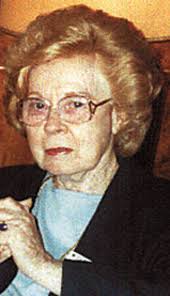
Aunt Marge
“He really seemed like a nice sensitive guy,” Linklater said, “who had done a very bad thing.” Linklater and Jodi Cole drove Bernie to Austin after the court okayed his release. He spent most of the trip staring out at the countryside, taking in a world he had come to believe he’d never see again. He was amazed by pretty much everything. Digital billboards. Hybrid cars. He’d never seen an IPhone before (because visitors to the penitentiary aren’t allowed to bring them in.) He burst into tears several times during the trip, completely overwhelmed.
And now – after two years of being free – Bernie faced the prospect of going back to prison, not eligible for parole until 2029, when he’ll be 71 years old, 10 years younger than Aunt Marge was on the day that he shot her.
My cousins, The Nugents, mounted an public relations campaign to get Bernie put back behind bars. They hired an Austin public relations guy, Ryan Gravatt, who among other things, set up a demonstration against Bernie’s release at the state Capitol, complete with paid protestors. They set up a website designed to portray Aunt Marge as a shy, kindly old woman, beloved grandmother and innocent victim of an evil con man/murderer. Other than the victim part – I mean, yes, he did shoot her in the back – none of that was true.
Aunt Marge had turned on her family years before she was murdered and was actively working to cut them out of trust funds that had been set up in their name. She had banished them from her life. (Which is part of the reason it took so long for anyone to realize she was missing.) When she died, though, there was an estimated $15 million estate to be had. Aunt Marge had left everything to Bernie and excluded her only son, Rod Nugent Jr., by name. The Nugents’ interest in the case didn’t seem to be motivated by justice or grief. It seemed to be about the money.
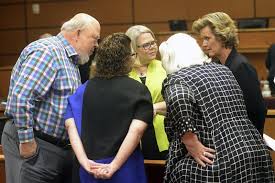
The Nugents huddling with state prosecutor Lisa Tanner
Which they got. Rod Nugent Jr. had scooped up a lot of financial documents on the day Aunt Marge’s body was found and, before anyone else knew what was going on, had probated a 1978 will from Aunt Marge – the last one from which he hadn’t been excluded – and took control of the estate. By the time anyone realized there were other wills – one from 1987 and one from 1991 – that would have left the money to others – including my mother – many of the assets had already been liquidated or otherwise dispersed. In the end my mom, taking some questionable legal advice, signed a settlement agreement giving up her claim to any part of the estate. Once she did that the Nugents got to keep the money, the entire $15 million estate, regardless of how or when they’d acquired it.
I mention all of this because I’m pretty sure it’s why The Nugents were so hostile to me when I first started doing the reporting about Aunt Marge’s murder. For weeks – this is back in 2011 – they refused to take my calls until, finally, Sylvia Nugent, Rod’s wife, picked up the phone just long enough to say, “We’re not going to talk to you about this,” and hung up. I was mystified. Then, a few weeks letter, I received a threatening letter from their attorney, basically saying that if I wrote anything about Aunt Marge or the case that they didn’t like they’d sue me. So I put that in the story. And never heard from them again.
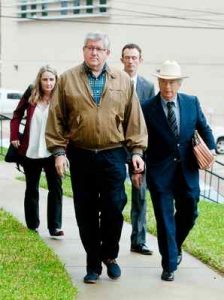
The defense team arrives.
Until the resentencing trial. By then, of course, The Nugents viewed me as an adversary, because I’d written the story they apparently didn’t want me to write. For the first few days in court they’d give me the evil eye whenever they walked by. I responded by grinning like a jackass. After that they wouldn’t look straight at me, except for Sylvia, who made a point of saying “Hello,” which I thought was very nice of her. Her daughter, Shanna, however, kept up the glaring whenever she thought I – or anyone else really – was looking her way. Later on, she’d make a point of sitting in front of potentially hostile witnesses and glowering at them. She also made a show, and not a very good one, of trying to look emotionally distraught whenever she thought the media or the jury was looking at her. She would rub her eyes, trying to tease out a tear. I don’t know whether she’s any good as an attorney, but she’s a terrible actress.
This is why, during the pre-trial motions, way too much time was spent trying to determine if I, as a potential witness, should be allowed in the courtroom. The Nugents had clearly convinced the state prosecutors – Lisa Tanner and Jane Starnes – that I was a problem. Which I wasn’t, really. My testimony was going to be about something that happened in 1968, a small sliver of the defense’s evidence that Aunt Marge was a bully. Still, they tried to get my testimony excluded and then they tried to keep me out of the courtroom.
“You’ve infected the case,” one of my reporter friends said to me while this was going on, while prosecutors were complaining – I swear this is true – that I should not be allowed to Tweet about anything involving the case, whether I was in the courtroom or not. It all seemed pretty silly to me. But not to The Nugents. In the end, I was allowed in the courtroom but not allowed to Tweet about the case or my involvement in it. The Nugents, as considerably more substantive witnesses probably shouldn’t have been able to sit in open court, were also allowed to stay. Which allowed them to not only give witnesses the oogie-boogie stares but to tailor their testimony based on who had gone on before them. It gave them a chance to get their stories straight. So, yeah, it was all kind of messed up before it even started.
Jury selection began – and I am absolutely not making this up – on April Fool’s Day. Because the case was so well-known, because there’d been a movie and people were wondering if Matthew McConaughey might show up (spoiler: he didn’t) the judge decided that 1,000 people would be summoned as potential jurors (the initial jury pool for the O.J. Simpson trial was only 250 people. ) The entire population of Rusk County is only 50,000. And chances were pretty high that most of them knew about the case, had seen the movie and probably had a pretty firm opinion as to whether Bernie ought to be locked up or not.
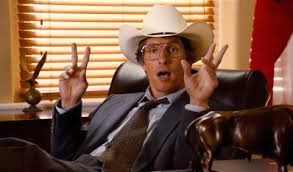
Matthew McConaughey: Not In Building
It was, I would venture to say, the most exciting thing to happen in Henderson since the oldest surviving Dairy Queen in Texas opened there in 1950. They had to move things to the Henderson Civic Center, because it was just too big an event for the county courthouse to hold. It looked like every pick-up truck in Texas was there. The parking lots overflowed (fortunately the wastewater treatment plant, just across the street, did not.) There were portable security gates and a thousand folding chairs set up in the main banquet hall. The judge, the defense team, the prosecution and, of course, Bernie, were at a raised dais overlooking it all. It looked like an American Idol audition, but without all the screaming or Ryan Seacrest making an ass out of himself.

The Henderson Civic Center
There were deputies in straw cowboy hats, six-shooters prominently displayed on their hips. There were orange and white-striped What-A-Burger cups, lots of guys chewing toothpicks and clearly jonesing for the chewing tobacco parked in their back pockets. Some them obviously didn’t want to be there (the guy who showed up in scrubs, for instance, making the point that he had a job in which LIVES WERE AT STAKE, DAMMIT!). But a lot of them, the majority I’d say, really did want to be a part of this, even though, officially they weren’t supposed to know which case they would be considering.
“You’ve probably figured out why you’re here,” the Judge, Diane DeVasto, said when she took her place at the dais and you could sense a thousand people thinking “Well, duh” The prosecutors and the defense attorneys introduced themselves, trying to look serious and important. Bernie just sat there, trying to look innocent.
The prospective jurors were given their instructions, told they couldn’t discuss the case with anyone, not even their families and that the trial was likely to take at least two weeks. Judge DeVasto asked if anyone felt there was a reason – such as knowing anyone associated with the case – why they couldn’t serve. At least 20 people raised their hands.
By the end of the day 186 potential jurors were left and they showed up on the following Monday at the Rusk County Courthouse for, basically, the elimination rounds
They were all given paddles with numbers and assigned seats in the courtroom pews. They were warned that anyone caught using a cell phone would have it confiscated and there would be a $10 fee for its return at the end of the day.
I tried to keep track of the jurors but there were just too many of them. I started identifying them with names like “Dandruff Guy” and “Too Much Hairspray Lady.”.
It took all day to whittle things down to the actual jury – 12 jurors and 2 alternates. It felt like a weird game show. If you answered a question wrong (“Do you have any problems with homosexuality?” “Did the movie, “Bernie,” convince you that Marjorie Nugent was a horrible person?” “Do you want to have sex with Matthew McConaughey?”) Okay, I made that last one up. I think. It was a very long day.
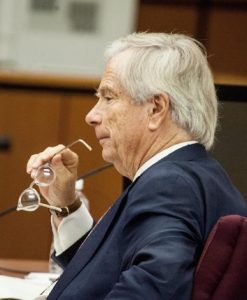
Mike DeGeurin
The prosecutors, as they would be for the entire trial, were a smooth-running machine, armed with slide presentations and well-practiced jokes about how they knew all the prospective jurors would rather be elsewhere. (Fact Check: False!) Lisa Tanner, whose courtroom demeanor trends toward “Mean P.E. Teacher,” smiled more when the jury was around. She wore earrings. And a skirt. She looked them in the eye. She remembered their names, not once calling them “Toothpick Guy” or “Mardi Gras Beads” or “Big Bow On Her Head Woman.” It was impressive.
The defense, on the other hand, seemed to be winging it. Mike DeGeurin spent so much time getting around to his actual questions that I became convinced he was pulling some kind of “Columbo” scam, stammering and getting things wrong (I’m pretty sure he never correctly got a single date or name right) just enough to throw off the prosecution and draw sympathy from the jury, who clearly wanted to finish his meandering drawn-out sentences for him. It was a brilliant strategy. Or so I hoped.
And Jodi Cole, who I’d come to truly admire, seemed completely out of her depth. She’d never tried a case in front of a jury before and had rarely been in court at all. Her specialty was appeals and settlements. She had invested so much time and emotional energy in Bernie’s case that she seemed to take every setback and adverse ruling personally. Instead of observing the fairly rigid courtroom rules of when and how to object, she’d occasionally just blurt out “But That’s Not Right, Your Honor!!” The judge did not seem to find this amusing. The prosecutors did, rolling their eyes every time Jodi breached protocol. Which was often.
Towards the end of the jury selection day, I started to realize that DeGeurin’s Columbo act wasn’t an act at all. He was just being himself, a folksy, self-deprecating guy who often has a hard time getting to the point. It can be, in person, an endearing quality. He spent hours – and I mean 5, 6 hours at a time – swapping tales with my mom, talking more about side-issues – flowers, the weather, what it’s like to grow up in East Texas – than anything related to the case. She found him charming as all get-out. The jury found him maddening.
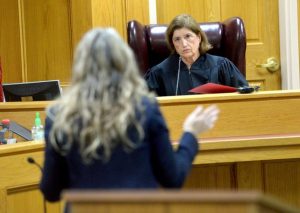
Judge Diane DeVasto giving Jodi Cole “the look.”
“You’re wasting our time,” one of the prospective jurors shouted out , shocking everyone in the courtroom.
“You could stand to talk a little faster,” shouted another. They were HECKLING him! The prospective jurors were actually heckling a defense attorney! This was not a good sign.
Still by the end of the day they had their 14 jurors and, from the looks of them, it was a younger, more sophisticated, more diverse jury than the one that had convicted Bernie 16 years ago in San Augustine. That jury pretty much fell off a turnip truck. This one seemed more likely to at least listen to Bernie’s case.
Which, as DeGeurin laid out in his opening arguments, was that it wasn’t their job to decide whether or not Bernie was a murderer. He was. They were there to decide only on appropriate punishment, considering all the evidence they were about to see and hear. They’d find out how Bernie had been sexually abused, how Aunt Marge had bullied and taunted him, how parts of his original confession which seemed to indicate pre-meditation were misleading if not outright false. There would be doubts raised about certain pieces of evidence, psychiatrists testifying that Bernie had in fact suffered from a kind of Post-Traumatic Stress Disorder, that he’d reacted to Aunt Marge’s particular abuses in a way that was inexcusable but not quite First Degree Murder.
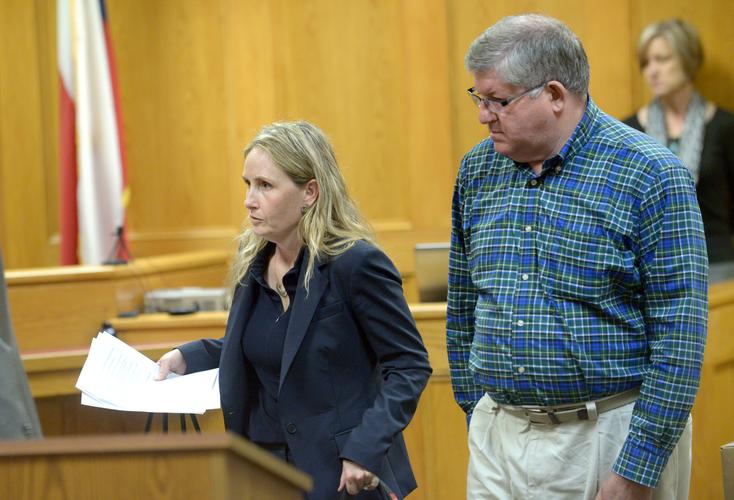
Jodi Cole and her client, Bernie Tiede.
They were being asked to decide whether Bernie had been punished enough. They could give him anywhere from five years probation to life. If they sentenced him to 20 years or less, then his temporary release would be made permanent. Justice would best be served, the attorneys argued, by giving Bernie a chance to live as a free man, making amends for the mistakes he’d made, supported by friends who cared about him, who trusted him, who saw him as a good man.
The prosecutors, on the other hand, wanted to re-create the murder trial, to convince the jury that Bernie had committed a crime so heinous, so calculated that a life sentence was the only appropriate response. Forget that adorable Jack Black character from the movie, they argued. Forget the Hollywood version. Punish him.
So those were the stakes. The next two weeks would play out as much like a political campaign as a murder trial, both sides questioning the integrity and motives of the other. The Nugents would go after me. Richard Linklater would go after the Nugents. There would be evidence of missing documents, secret sex tapes and stolen money hidden away. My mother would testify. Linklater would testify. And I would testify, too.
But that’s the next part of the story. Coming soon.
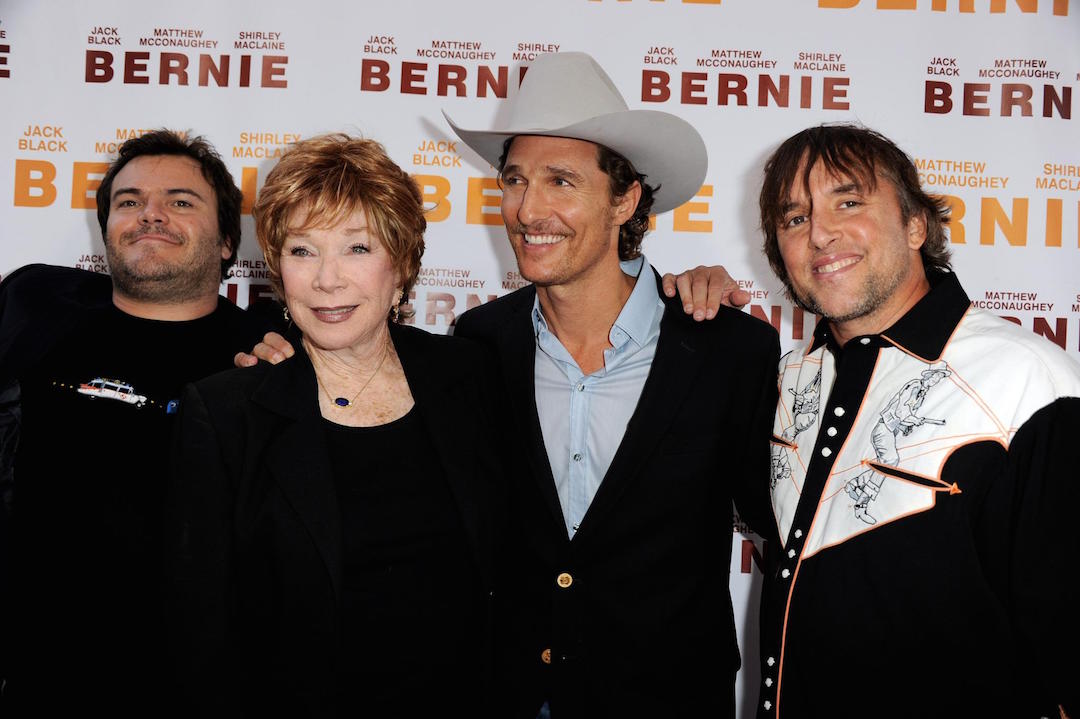
Richard Linklater and the cast of “Bernie,” 2012